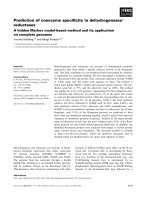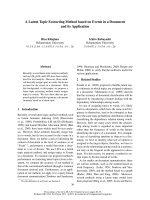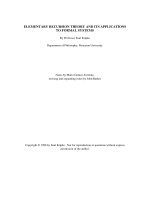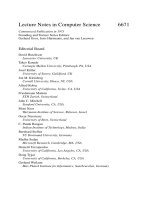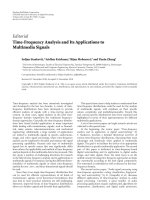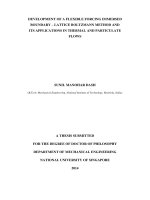On bicubic b spline method and its applications to structural dynamics
Bạn đang xem bản rút gọn của tài liệu. Xem và tải ngay bản đầy đủ của tài liệu tại đây (1.28 MB, 114 trang )
ON BICUBIC B-SPLINE METHOD AND ITS
APPLICATIONS TO STRUCTURAL DYNAMICS
SI WEIJIAN
NATIONAL UNIVERSITY OF SINGAPORE
2003
ON BICUBIC B-SPLINE METHOD AND ITS
APPLICATIONS TO STRUCTURAL DYNAMICS
SI WEIJIAN
A THESIS SUBMITTED
FOR THE DEGREE OF MASTER OF ENGINEERING
DEPARTMENT OF MECHANICAL ENGINEERING
NATIONAL UNIVERSITY OF SINGAPORE
2003
ACKNOWLEDGEMENTS
I wish to express my heartfelt gratitude to my supervisors, Prof. Lam Khin Yong and
Dr. Gong Shi Wei. I will be forever grateful for the way they always helped me think
about research from a wider perspective; and for all their down-to-earth advice and
encouragement.
I also want to express my thanks for Dr. Zong Zhi, Dr. Ng Teng Yong and Dr. Li Hua.
From them I learned a tremendous amount about both doing research and presenting it.
I also thank Ms. Zhang Yingyan, Mr. Zhang Jian, Mr. Yew Yong Kin, Mr. Chen Jun
and Mr. Wang Zijie, with whom I shared my research experience in the Institute of
High Performance Computing.
I would like to express my thanks to the lab mates of the Dynamic/Vibration Lab,
including Mr. Lu Feng, Mr. Khun Min Swe, Mr. Tao Qian and Ms. Zeng Ying, for
their friendships and for all they have done for me.
I am deeply indebted to my dear wife, Guxiang, for her love and understanding
through my graduate years. She was always behind me and gave her unconditional
support even if that meant to sacrifice the time we spent together.
i
TABLE OF CONTENTS
ACKNOWLEDGEMENTS
i
TABLE OF CONTENTS
ii
ABSTRACT
v
LIST OF FIGURES
vii
LIST OF TABLES
viii
LIST OF NOTATIONS
xi
Chapter 1
1
INTRODUCTION
1.1
Introduction
1
1.2
Application of B-spline Functions to Numerical Analysis
2
1.3
Review of Vibration Analysis of Plates Using B-spline
5
Functions
1.4
Chapter 2
Arrangement of the Thesis
THE NEW FORM OF B-SPLINE BASIS SETS
9
11
2.1
Introduction
11
2.2
Description of B-splines
12
2.3
Review of Two Forms of B-spline Basis Sets
17
2.3.1 The Form by Qin (1985)
17
2.3.2 The Form by Yuen (1999)
18
2.4
Why the New Form?
20
2.5
Beam Function Approximation
22
ii
Chapter 3
2.5.1 Beams Under the Three Classical B.C.s
22
2.5.2 Beams with at Least One Guided Edge
24
VIBRATION ANALYSIS OF ORTHOTROPIC PLATES
26
3.1
Introduction
26
3.2
Review of Vibration of Rectangular Plates
27
3.3
Bicubic B-spline Approximation
31
3.4
Frequency Equation Formulation
35
3.5
Imposition of Boundary Conditions
37
Chapter 4
NUMERICAL RESULTS FOR VIBRATION OF
ORTHOTROPIC PLATES
41
4.1
Introduction
41
4.2
Program Design
42
4.3
Convergence Study
45
4.4
Validation of Bicubic B-spline Method
48
4.4.1 C-C-S-S Isotropic Plate
48
4.4.2 Completely Free Isotropic Plate
48
4.4.3 Fundamental Frequencies of Six Cases of Orthotropic
50
Plates
4.4.4 Five Cases of Orthotropic Plates with Different Boundary
52
Conditions
4.5
Chapter 5
Numerical Results by the Present Method
VIBRATION OF PLATES WITH GUIDED EDGE(S)
55
62
5.1
Introduction
62
5.2
Imposition of Boundary Condition of Guided Edge
64
iii
5.3
Comparison with Exact Solutions
65
5.4
Numerical Results by the Present Method
67
5.5
Discussions
74
5.5.1 Meshfree feature of the bicubic B-spline method
74
5.5.2 Advantages of the present bicubic B-spline method
75
Chapter 6
BICUBIC B-SPLINE METHOD FOR TRANSIENT
77
ANALYSIS
6.1
Introduction
77
6.2
Dynamic Equation
78
6.3
Newmark-beta Integration
79
6.4
Numerical Example
81
6.5
Discussion on the Efficiency of the Present Method
83
Chapter 7
CONCLUSIONS AND RECOMMENDATIONS
84
7.1
Conclusions
84
7.2
Recommendations
85
APPENDIX A
Notes on Kronecker product
87
APPENDIX B
Elements of the Spline Matrices
90
REFERENCES
92
iv
ABSTRACT
The present thesis focuses on the development of bicubic B-spline method in
combination with a new form of B-spline basis set for dynamics analysis of structures.
A new form of B-spline basis set is first proposed to enrich greater generality of the
application of B-spline functions to numerical analysis. The development of the new
form of cubic B-spline basis set is of considerable significance, since it is much more
versatile than are other kinds of beam functions or polynomials with regard to the
variety of end conditions that can be accommodated, and there’s no problem in
meeting the end conditions for guided edge.
Using the new form of B-spline basis set, bicubic B-spline approximation procedure
is developed for vibration analysis of orthotropic plates. The plate deflection is
approximated by the product of the new form of B-spline basis set in both x- and ydirections. The frequency characteristic equation is derived based on classical thin
plate theory by performing Hamilton's principle. Various boundary conditions can be
handled in this method, and furthermore, in this method the imposition of boundary
conditions is very simple.
A general unified Fortran computer program capable of analyzing vibration of
orthotropic as well as isotropic plates under any combination of the four kinds of
boundary conditions is developed. There exist 36 combinations of the three classical
v
edge conditions, i.e. simply supported, clamped, and free edge conditions, for
rectangular orthotropic plates. The natural frequencies of orthotropic plates with all
36 combinations of the three classical boundary conditions with various aspect ratios
are presented.
Comparisons with exact solutions and other numerical results
demonstrate fast convergence, high accuracy, versatility, and computation efficiency
of the present approach.
In addition to the three classical edge conditions (i.e. simply supported, clamped, and
free edges), the fourth mathematically possible boundary condition has been referred
to in the literature as the guided edge. The number of all possible combinations is 34
when at least one guided edge is involved. Of all these 34 cases, analytical solution is
possible for 21 cases only. The solutions of the remaining 13 cases are possible by
approximate or numerical methods only, however, no investigation has been reported.
To show the versatility of the present method, the results for rectangular plates with at
least one guided edge are also computed.
The present method results in a significant reduction in degrees of freedom compared
to conventional FEM, which is desirable for dynamic analysis of complex structures.
Linear transient analysis is also carried out for plate structures and a simple example
is provided to shown the high effectiveness of the present method.
vi
LIST OF FIGURES
Figure 2.1
Standard cubic B-spline function
13
Figure 2.2
Beam function approximation by ordinary cubic B-spline
15
functions
Figure 3.1
Plate deflection approximation by B-spline basis set
32
( x − direction)
Figure 4.1
Flowchart of the program
44
Figure 5.1
Guided (or sliding) edge
63
Figure 6.1
Step load acting on the structure
82
Figure 6.2
Response of a simply-supported plate to step load
82
vii
LIST OF TABLES
Table 4.1
Boundary indices and corresponding boundary conditions
43
Table 4.2
Convergence of frequency coefficient Ω = ωa 2 ρ D for S-S-S-S
46
isotropic square plate (* double eigenfrequencies)
Table 4.3
Convergence of frequency coefficient Ω = ωa 2 ρ D y for clamped
47
orthotropic square plate
Table 4.4
Frequency coefficient Ω = ωa 2 ρ D for C-C-S-S rectangular plate
48
with different aspect ratios
Table 4.5
Comparison of Natural Frequencies (Hz) of Completely Free
49
Orthotropic Plate
Table 4.6
Fundamental frequency coefficient p11 a 2 ρh D y for rectangular
51
plywood plates with different boundary conditions
Table 4.7
Comparison of exact and approximate frequencies of S-F-S-C plywood 51
plate
Table 4.8
Dimensionless natural frequencies for the E-glass/epoxy rectangular
53
C-S-C-S plate with different aspect ratios
Table 4.9
Dimensionless natural frequencies for the E-glass/epoxy rectangular
53
C-S-S-S plate with different aspect ratios
Table 4.10 Dimensionless natural frequencies for the E-glass/epoxy rectangular
54
viii
S-S-F-S plate with different aspect ratios
Table 4.11 Dimensionless natural frequencies for the E-glass/epoxy rectangular
54
C-S-F-S plate with different aspect ratios
Table 4.12 Dimensionless natural frequencies for the E-glass/epoxy rectangular
55
F-S-F-S plate with different aspect ratios
Table 4.13 Bicubic B-spline solution for frequency parameters of orthotropic
57
rectangular plates under general edge conditions (r =0.4)
Table 4.14 Bicubic B-spline solution for frequency parameters of orthotropic
58
rectangular plates under general edge conditions (r =2/3)
Table 4.15 Bicubic B-spline solution for frequency parameters of orthotropic
59
rectangular plates under general edge conditions (r =1)
Table 4.16 Bicubic B-spline solution for frequency parameters of orthotropic
60
rectangular plates under general edge conditions (r =1.5)
Table 4.17 Bicubic B-spline solution for frequency parameters of orthotropic
61
rectangular plates under general edge conditions (r =2.5)
Table 5.1
Rectangular plate configurations based on possible combinations of
63
simply supported, clamped, free and guided edges (one or more
guided edges)
Table 5.2
Comparison of frequency parameters for SCSG plate
66
Table 5.3
Comparison of frequency parameters for SGGF plate
66
Table 5.4
Comparison of frequency parameters for GGGG plate
67
Table 5.5
Bicubic B-spline solutions of frequency parameters for CCCG plate
68
Table 5.6
Bicubic B-spline solutions of frequency parameters for CCSG plate
68
Table 5.7
Bicubic B-spline solutions of frequency parameters for CCGF plate
69
ix
Table 5.8
Bicubic B-spline solutions of frequency parameters for CCGG plate
69
Table 5.9
Bicubic B-spline solutions of frequency parameters for CGCF plate
70
Table 5.10 Bicubic B-spline solutions of frequency parameters for CGSF plate
70
Table 5.11 Bicubic B-spline solutions of frequency parameters for CSGF plate
71
Table 5.12 Bicubic B-spline solutions of frequency parameters for CGGF plate
71
Table 5.13 Bicubic B-spline solutions of frequency parameters for CFGF plate
72
Table 5.14 Bicubic B-spline solutions of frequency parameters for SGFF plate
72
Table 5.15 Bicubic B-spline solutions of frequency parameters for CGFF plate
73
Table 5.16 Bicubic B-spline solutions of frequency parameters for GGFF plate
73
Table 5.17 Bicubic B-spline solutions of frequency parameters for GFFF plate
74
Table 5.18 Comparison of total DOF numbers of different methods
74
x
LIST OF NOTATIONS
a = plate length in x-direction;
b = plate breadth in y-direction;
[ Ax ],[ Bx ],[C x ] , [ Fx ]
[ Ay ], [ B y ], [C y ] ,[ Fy ]
Ci (i = −1,0,1L N − 1, N , N + 1)
= spline matrices;
= undetermined coefficients at the spline nodes;
d = uniform thickness of plate;
Dx , D y
= flexural rigidity constants;
D xy
= shear stiffness;
[D]
= flexural rigidity matrix;
E, E x , E y
= elastic modulus;
[ E x ], [ Fx ]
= spline matrices;
G, G xy
= shear modulus;
hx
= a/N ;
hy
= b/M ;
[K ] = stiffness matrix;
l
= beam length;
M = number of equivalent sections along y-direction;
Mx, M y
= bending moments;
M xy
= twisting moment;
[M ]
= mass matrix;
N
= number of equivalent sections along x-direction;
qt
= distributed dynamic load;
xi
T
u (x)
= kinetic energy;
= beam deflection;
U
= strain energy;
V
= virtual work due to external force;
u , v, w
w( x, y )
[U ], [V ], [W ]
x, y , z
µ , µ xy , µ yx
=
displacement components in the x -, y -, and z -directions,
respectively;
= transverse displacement of plate;
=
displacement vectors in the x -, y -, and z -directions,
respectively;
= Cartesian coordinate system;
= Poisson’s ratio;
ρ
= area mass density of plate;
ω
= natural frequency of the mode;
ϕ 3 ( x)
= local B3-spline function;
[φ ( x)]
= B3-spline function vector;
φ i ( x)
= i th local spline function along x − direction;
ψ j ( y)
= j th local spline function along y − direction;
Π
= total dynamic potential;
{δ }
= undetermined spline nodal coefficient vector; and
⊗
= Kronecker product of two matrices or two vectors.
xii
CHAPTER 1
INTRODUCTION
1.1 Introduction
Since the invention of the finite element method (FEM) in the 1950s, FEM has
become the most powerful and versatile technique in engineering computations. A
prominent feature of the FEM is that it divides the domain of the continuum into
discrete elements, usually triangular, rectangular, or quadrilateral elements of finite
size. This procedure of dividing is called discretization. The displacement or stress
field within each element is expressed in terms of a set of unknown nodal parameters.
The minimization of the global potential energy yields either a set of linear equations
or nonlinear equations. The method is suitable for analysis involving all types of
structures under static and dynamic loads.
However, this procedure is not always advantageous. For example, for many cases of
practical structures, the efficiency of the FEM needs to be improved because the finite
element usually requires significant storage capacity, tedious and lengthy input data
files. In addition, in problems with high gradients or a distinct local character, very
fine mesh is often required, which can be computationally expensive. Therefore,
1
other alternative specialized approximation techniques, for example, spline
approximation technique, play their own roles in numerical structural analysis.
1.2 Application of B-spline Functions to Structural Analysis
The modern mathematical theory of spline approximation was pioneered by
Schoenberg (1946a, b) and he also coined the name (Schoenberg 1967). The name is
derived from a draftsman’s spline, a flexible piece of rubber, which can be used to
draw smooth curves. The spline is pinned down at known points (called knot points
in the following) on the otherwise perhaps unknown or perhaps irregular curve. The
flexibility of the spline now allows us to draw a continuous curve between the points
with continuous first and second derivatives at all points.
B-splines have the property of being ‘complete enough’ with a relatively small
number of basis functions and linear dependences are negligible. This accounts for
the recent swing towards the use of B-splines in engineering numerical analysis. The
basis set methods can be characterized as a kind of ‘global’ method, i.e. the solution at
one point is linked to the solutions at all other points. A consequence, as we shall see,
is that a good working knowledge of which basis set to use under particular
circumstances is required.
B-spline functions have desirable characteristics, such as piecewise form, smoothness,
capacity to handle local phenomena and higher-order continuity, for numerical
analysis. B-spline functions were initially used in approximation problems, such as
2
surface fitting, curve design, and interpolating. The application of B-spline functions
has emerged as a new direction of research in engineering computations (Fan and
Luah, 1992).
Mizusawa et al (1979,1980,1986) used B-spline functions of various orders as
coordinate functions in the Rayleigh-Ritz method to solve the problem of vibration
and buckling of skew plates. Fujii (1981) and Fujii and Hoshino (1983) applied Bspline functions in the discrete and non-discrete mixed methods for bending and
eigenvalue problems of plates. Shen and Wang (1987) investigated the static and
vibration analysis of isotropic flat shells using cubic and quintic B-spline functions in
one direction and beam functions in the other one. Most recently, Li and Si (2003)
implemented bending analysis of orthotropic plates and shells by using cubic B-spline
function in one direction and sine and cosine function in another as displacement
interpolation functions.
The most prominent development in the application of spline functions for numerical
analysis was perhaps the development of spline finite strip method by Cheung et al
(1982). In this method, the displacement functions were written as the product of
spline function in one direction and suitable piecewise continuous polynomials, e.g.
Hermite cubic polynomials (Kong and Cheung, 1995) and Lagrange polynomials (Au
and Cheung, 1996), in another. The method is now capable of solving a broad range
of structural problems. Cheung et al carried out static analysis of right box girder
bridges (Cheung and Fan 1983), analysis of curved slab bridges (Cheung, Tham and
Li, 1986), large deflection analysis of arbitrary shaped thin plates (Cheung and
Dashan 1987), free vibration and static analysis of general plate (Cheung, Tham and
3
Li, 1988), postbuckling analysis of circular cylindrical shells under external pressure
(Cheung and Zhu 1989), linear elastic stability analysis of shear-deformable plates
(Cheung and Kong 1993) by the spline finite strip method
A spline strip method, in which the displacement function was expressed as the
product of basic function series in the longitudinal direction and B-spline functions in
the other direction, was also developed by Mizusawa (1988). Vibration of open
cylindrical shells (Mizusawa 1988), annular sector plates (Mizusawa 1991a), and
stepped annular sector plates (Mizusawa 1991b), vibration and buckling of plates with
mixed boundary conditions (Mizusawa and Leonard 1990), were analyzed by
Mizusawa and his colleagues by using spline strip method.
Both the spline finite strip method and the spline strip method employ cubic B-spline
functions in one direction only.
To fully exploit the desirable numerical
characteristics of B-spline function, it’s reasonable to express the displacement
function in two directions rather than in one. The approximation technique using Bspline functions in two directions is called bicubic B-spline approximation.
The mathematical concept of bicubic spline interpolation was first proposed by Boor
(1962). This interpolation technique was originally used in approximation problems,
such as surface fitting, curve design, and interpolating.
The first application of
bicubic splines in engineering analysis was reported in 1974 by Antes, in which plate
bending problem was solved by bicubic fundamental splines. Later, Shen et al (1992)
presented so-called multivariable spline element method for vibration analysis of
isotropic plates. In a more recent work, Yuen et al (1999) reported a macro spline
4
finite element for transient analysis of thin-walled structures, in which twodimensional cubic B-spline interpolation was used. The advantages of B-splines
interpolation such as higher accuracy and efficiency in the solution have been
observed.
1.3 Review of Vibration Analysis of Plates Using B-spline Functions
The vibration problem of rectangular plates, although now more than two hundred
years old in the research account, continues to be of considerable academic and
practical interest, since a rectangular plate is a basic structural element and enormous
parametric variations, for example, loading, materials, aspect ratio and edge
conditions may be encountered in practical applications.
Closed form solutions for rectangular plate vibration problem are known only for
certain cases in which at least a pair of opposite sides is simply supported. Energy
methods such as Ritz method or Rayleigh-Ritz are employed for plates with other
types of edge conditions. It is characteristic of those energy methods that one must
choose a set of functions to represent the shape of the deformed plate and the
accuracy of frequencies depends to a large extent upon the set of functions that is used
to represent the vibration mode.
Employing the beam mode functions to represent the mode shapes of the vibrating
plates, the approximate methods are very convenient and have been used most
extensively, e.g., Young (1950), Warburton (1954), Hearmon (1959), Leissa (1973),
5
Rajalingham et al (1996). This procedure is very well known (for example, Young
1950, Leissa 1969) and will not be described in detail again here. Suffice it to say
that the method uses functions W ( x, y ) in the variables separable form to represent
the mode shapes of the vibrating plates (Leissa 1973),
W ( x, y ) = ∑ A pq X p ( x)Yq ( y )
(1.1)
p ,q
where X p and Yq are normalized eigenfunctions exactly satisfying the equation of
motion of a freely vibrating, uniform beam.
The beam functions do satisfy prescribed geometrical boundary conditions of zero
deflection and zero slope where required, therefore, clamped and simply supported
plate boundary conditions are exactly satisfied by use of beam functions. However,
should one or more free edges be involved the accuracy of frequencies can be
significantly diminished (Leissa 1973).
Other researchers have used the products of a series of polynomials to approximate
the plate deflection, e.g. sine series (Dickinson 1969), double trigonometric series
(Sakata and Hosokawa 1988), discrete Green functions (Morita et al 1995), etc.
However, accurate results can be obtained only for plates with certain boundary
conditions, especially clamped or simply supported edges, due to the difficulty
encountered when dealing with free edges using these polynomials.
In the energy approaches, using the beam functions or other kinds of polynomials,
many different products of regular and hyper trigonometric functions exist for
arbitrary conditions and it is difficult to make a unified subroutine to calculate all of
6
the various kinds of integrals. As a result, these investigations, for the most part, have
been concerned with plates having certain combinations of edge conditions, thus
different formulation procedures must be carried out for plates with different
combinations of edge conditions, even utilizing the same method.
Simple and unified method which can deal with plate vibrations under general edge
conditions have been of academic and practical interest for many decades and very
little investigation has been reported. For isotropic plates, Leissa (1973) used the
Rayleigh-Ritz method to determine natural frequencies for several modes for all
combinations of clamped, simply supported and free edges. In which, analytical
solutions are given for six cases of plates with a pair of opposite edges, and
approximate solutions using 36 terms beam functions for other 15 cases are provided.
It remains a fact, nevertheless, that little attempts have been made on the natural
frequencies of orthotropic pates under general edge conditions, except the remarkable
one by Narita (2000). In his work, a modified Ritz method was used to calculate
frequency parameters of orthotropic plates under all 36 combinations of edge
conditions, although the results for square plates only were given. He introduces a
kind of polynomial as follows:
X m (ξ ) = ξ m (ξ + 1) B1 (ξ − 1) B 3
(1.2)
Yn (η ) = η n (η + 1) B 2 (η − 1) B 4
(1.3)
where B1 , B2 , B3 , and B4 are ‘‘boundary indices’’ which are added to satisfy the
kinematical boundary conditions and are used in such a way as B1 =0 for F (free
edge), 1 for S (simply supported edge), and 2 for C (clamped edge).
7
However, as pointed out by Bert (2001), this kind of polynomial proposed by Narita
(2000) is applicable to the three classical boundary conditions (i.e. simply supported,
clamped, and free) only. Actually, there is a fourth boundary condition which has
been referred to in the literature as the guided (Bert and Malik 1994) or sliding
(Ugural 1999) edge. For this boundary condition, the effective shear force and the
bending slope are both zero. This boundary condition has been little studied in
literature except the remarkable one by Bert and Malik (1994).
The number of the possible combinations of the three classical edge conditions
(simply supported, clamped, and free) is 21. When at least one guided edge condition
is involved, the possible combinations of the three classical edge conditions give rise
to 34 additional cases. Of all these 34 cases, analytical solution is possible for 21
cases only and has been investigated by Bert and Malik (1994). The solutions of the
remaining 13 cases are possible by approximate or numerical methods only, however,
no investigation has been reported. In the present thesis, a novel method, called
bicubic B-spline method is developed to solve plate vibration problem under any
combination of the four kinds boundary conditions.
The enforcement of boundary conditions has been one of the most important
considerations in the application of B-splines to numerical structural analysis. Shen
and He (1992) investigated the vibration analysis of isotropic plates using so-called
multivariable spline element method. In this method, the kind of B-spline basis set
proposed by Qin (1985) was adopted to approximate the displacement function of the
plate. However, the kind of B-spline basis set is not able to satisfy free or guided
8
edges.
Thus this research has been limited to certain combinations of simply
supported and clamped edge conditions.
In the present thesis, a new form of cubic B-spline basis set, which can accurately
satisfy simply supported, clamped and free edge conditions, is constructed to
accurately approximate beam functions under any boundary conditions.
The
development of the new form of cubic B-spline basis set is of considerable
significance, since it is much more versatile than are other beam functions or
polynomials with regard to the variety of end conditions that can be accommodated,
and there’s no problem in meeting the end conditions for guided edge.
1.4 Arrangement of the Thesis
The present thesis is arranged into 7 chapters, as follows:
Chapter 1 reviews previous research into the application of B-spline functions in
numerical structural analysis and hence indicates the necessity of the present study.
Chapter 2 proposes a new form of B-spline basis set and presents the desired
numerical characteristics of the form of B-spline basis set.
Chapter 3 details the formulation of the eigenvalue equation of vibration of
orthotropic plates using bicubic B-spline method.
Chapter 4 demonstrates extensively the numerical examples of the vibration analysis
of orthotropic plates with arbitrary combination of the three classical edge conditions,
i.e. simply supported, clamped, and free boundary conditions.
9
Chapter 5 gives the numerical results for free vibration analysis of rectangular plates
with at least one guided edge.
Chapter 6 applies bicubic B-spline method for transient response analysis in
conjunction with Newmark Beta method, simple example is provided to demonstrate
the effectiveness and accuracy of the bicubic B-spline method.
Conclusions and recommendations for future work are detailed in Chapter 7.
10
CHAPTER 2
THE NEW FORM OF B-SPLINE BASIS SET
2.1 Introduction
The construction of boundary B-spline functions has been recognized as one of the
most important considerations in the application of B-spline functions in structural
numerical analysis.
At both ends of plate, there exist three truncated B-spline
functions and those truncated B-spline functions are not orthogonal, i.e. a few
coefficients can appear at the ends. It is desired for numerical analysis that only one
unknown coefficient appears for a certain boundary condition. Thus the B-spline
basis functions need to be reconstructed to satisfy different boundary conditions at the
end.
Several kinds of B-spline basis set have been proposed in literature (Qin 1985, Yuen
et al 1999). However, application inconvenience can be encountered for those plates
and shells involving free or guided edges using those existing B-spline basis set. To
introduce greater generality of the application of B-spline functions in numerical
analysis, a new form of B-spline basis set, which can be able to accommodate
11
